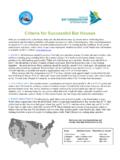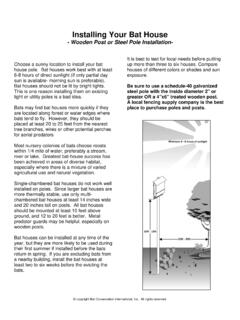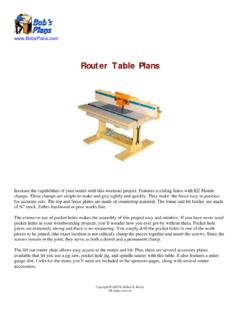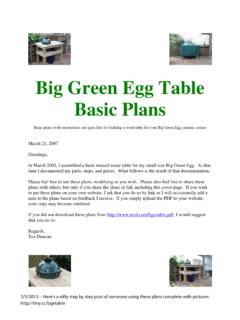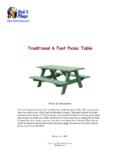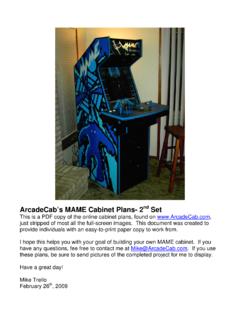Transcription of Four-chamber Nursery House - Bat Conservation International
1 Materials (makes two houses) D i a g ra m son pages 12 &131 2sheet (4' x 4') 1 2" AC, BC or T1-11 (outdoor grade) plywood1 2sheet (4' x 4') 3 8" AC or BC (outdoor grade) plywoodTwo pieces 1" x 6" (3 4" x 51 2" finished) x 8' pine or cedar One lb. coated deck or exterior-grade screws, 15 8"20 to 25 coated deck or exterior-grade screws, 11 4"20 to 25 exterior-grade screws, 1"One quart dark, water-based stain, exterior gradeOne quart water-based primer, exterior gradeTwo quarts flat water-based paint or stain, exterior gradeOne tube paintable latex caulkBlack asphalt shingles or galvanized metal12 to 20 roofing nails, 7 8"Recommended toolsTable saw or circular sawPaintbrushes Variable-speed reversing drillHammer (optional)Screwdriver bit for drillTin snips (optional)Tape measure or yardstickBar clamp (optional)Caulking gunSander (optional)11 2" hole saw or spade bitCo n s t ru c t i o n1.
2 Measure, mark and cut out all wood according to the saw-ing diagrams on pages 12 and Roughen interior and landing surfaces by cutting horizontalgrooves with sharp object or saw. Space grooves 1 4" to 1 2"apart, cutting 1 32" to 1 16" Apply two coats of dark, water-based stain to interior sur-faces. Do not use paint, as it will fill Attach side pieces to back, caulking first. Use 15 8" sure top angles match. 5. Attach 5" and 10" spacers to inside corners per drawings onpage 12. Use 1" screws. Roost chamber spacing will be 3 4"(front to back). Do not block side Place first roosting partition on spacers even with bottomedge of roof. Place 20" spacers on partition and screw tofirst spacers (through partition), using 15 8" Repeat step 6 for remaining spacers and Attach front to sides, top piece first (caulk seams).
3 Be suretop angles match (sand if necessary). Leave1 2" vent spacebetween top and bottom front pieces. A bar clamp may beuseful if sides have flared out during Attach roof supports to the top inside of front and backpieces with 1" screws. Don t let screws protrude into roost-ing around all top surfaces, sanding first if necessary toensure good fit with roof to sides and roof supports with 11 4" around roof and side joints to further guard againstleaks and drafts. Don t let screws protrude into or stain exterior three times (use primer for first coat). roof with shingles or galvanized modifications1. These Nursery -housedimensions were chosento permit constructionof two bat houses per half-sheet of plywood. Increasinghouse width to 24" or moreor adding partitions benefitsbats and attracts largercolonies.
4 Additional spacersare required to prevent warp-ing of roost partitions forhouses more than 24" wide. 2. Taller bat houses provideimproved temperature gradi-ents and may be especiallyuseful in climates where dailytemperatures fluctuate houses 3' or taller should havethe horizontal vent slot 12" from thebottom of the roosting Two bat houses can be placed b a c k - t o - b a c kmounted on poles. Be f o re assembly, a horizontal 3 4"slot should be cut in the back of each House about 10"f rom the bottom edge of the back piece to permit move m e n tof bats between houses. Two pieces of wood, 1" x 4" x 103 4" ,s c rewed horizontally to each side, will join the two boxe s .L e a ve a 3 4" space between the two houses, and roughen thewood surfaces or cover the back of each with plastic 2" x 4" x 40" ve rtical piece, attached to each side, ove rthe horizontal pieces, blocks light but allows bats and air toe n t e r.
5 Use a 2" x 6" ve rtical piece if securing houses with U-bolts to metal poles. A galva n i zed metal roof that covers bothhouses protects them and helps pre vent overheating. Eave sshould extend about 3" in front in southern areas and about11 2" in the north. 4. Ventilation may not be necessary in cold climates. In thatcase, the front of the bat House should be a single, 23"-longpiece. Far-northern bat houses may also benefit from a partialbottom to help retain heat. Slope the sides and bottom at anangle of 45 or greater to reduce guano build-up. Leave a 3 4"entry gap at the back and be sure the bottom does not inter-fere with access to the front crevices. A hinged bottom isrequired to permit annual Durable plastic mesh can be substituted for mesh to backboard, landing area and one side of eachpartition after staining interior, but prior to assembly.
6 Use 1 8"-or 1 4"-inch HDPE plastic mesh [such as Internet product#1672 (1-800-328-8456; )] and attachevery two inches with 5 16" Monel or stainless steel staples. 6. Make partitions removable by attaching small cleats withthumbscrews to the bottom of side pieces for support. Spacerstrips are unnecessary if grooves for partitions are cut in theside pieces with a router or dado saw blade. Bat Conservation International , from The Bat House Builder s HandbookFour- chamber Nursery HouseSide ViewBottom View3/4"spacersfront ventfrontbackroof supportslanding area1/2"sideventBat Conservation Internationalroof overhang157/8"157/8"5"6"157/8"157/8"25"2 5"1/2"23"23"roof supportsroof supports41/8"6"6"6"1" x 6" x 8' board5"1/2"1/2"5"1/2"FIGURE 4 four -chamberNursery HouseAssembly Diagrams41/8"5"12 The Bat House Builder s Handbook Bat Conservation International , from The Bat House Builder s Handbook25 degree bevelextra materialFIGURE 5Fo u r - c h a m b e rNu r s e ry Ho u s eSawing Diagramsfront (upper)front (upper)
7 Backback171/2"171/2"51/2"51/2"20"*171/2" 171/2"61/2"61/2"31"1 7"4' x 4' x 1/2"plywood*19" if mounted between two poles171/2"157/8"157/8"157/8"157/8"157/8 "157/8"4' x 4' x 3/8"plywoodpartition 2partition 3partition 1partition 2partition 3partition 111 2" diameterpassage holes22"1" x 6" x 8' boards p a c e r s :5" spacers = back bottom10" spacers = back top20" spacers = others10"11/4"20"20"20"5"10"20"Bat House Plans 132 2"
